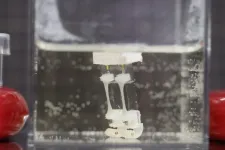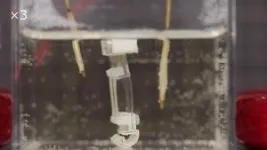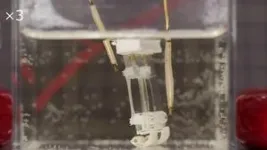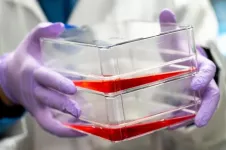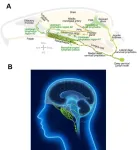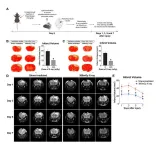(Press-News.org) Compared to robots, human bodies are flexible, capable of fine movements, and can convert energy efficiently into movement. Drawing inspiration from human gait, researchers from Japan crafted a two-legged biohybrid robot by combining muscle tissues and artificial materials. Publishing on January 26 in the journal Matter, this method allows the robot to walk and pivot.
“Research on biohybrid robots, which are a fusion of biology and mechanics, is recently attracting attention as a new field of robotics featuring biological function,” says corresponding author Shoji Takeuchi of the University of Tokyo, Japan. “Using muscle as actuators allows us to build a compact robot and achieve efficient, silent movements with a soft touch.”
The research team's two-legged robot, an innovative bipedal design, builds on the legacy of biohybrid robots that take advantage of muscles. Muscle tissues have driven biohybrid robots to crawl and swim straight forward and make turns—but not sharp ones. Yet, being able to pivot and make sharp turns is an essential feature for robots to avoid obstacles.
To build a nimbler robot with fine and delicate movements, the researchers designed a biohybrid robot that mimics human gait and operates in water. The robot has a foam buoy top and weighted legs to help it stand straight underwater. The skeleton of the robot is mainly made from silicone rubber that can bend and flex to conform to muscle movements. The researchers then attached strips of lab-grown skeletal muscle tissues to the silicone rubber and each leg.
When the researchers zapped the muscle tissue with electricity, the muscle contracted, lifting the leg up. The heel of the leg then landed forward when the electricity dissipated. By alternating the electric stimulation between the left and right leg every 5 seconds, the biohybrid robot successfully “walked” at the speed of 5.4 mm/min (0.002 mph). To turn, researchers repeatedly zapped the right leg every 5 seconds while the left leg served as an anchor. The robot made a 90-degree left turn in 62 seconds. The findings showed that the muscle-driven bipedal robot can walk, stop, and make fine-tuned turning motions.
“Currently, we are manually moving a pair of electrodes to apply an electric field individually to the legs, which takes time,” says Takeuchi. “In the future, by integrating the electrodes into the robot, we expect to increase the speed more efficiently.”
The team also plans to give joints and thicker muscle tissues to the bipedal robot to enable more sophisticated and powerful movements. But before upgrading the robot with more biological components, Takeuchi says the team will have to integrate a nutrient supply system to sustain the living tissues and device structures that allow the robot to operate in the air.
“A cheer broke out during our regular lab meeting when we saw the robot successfully walk on the video,” says Takeuchi. “Though they might seem like small steps, they are, in fact, giant leaps forward for the biohybrid robots.”
###
This work was supported by JST-Mirai Program, JST Fusion Oriented Research for disruptive Science and Technology, and the Japan Society for the Promotion of Science.
Matter, Kinjo et al. “Biohybrid bipedal robot powered by skeletal muscle tissue” https://cell.com/matter/fulltext/S2590-2385(23)00648-3
Matter (@Matter_CP), published by Cell Press, is a new journal for multi-disciplinary, transformative materials sciences research. Papers explore scientific advancements across the spectrum of materials development—from fundamentals to application, from nano to macro. Visit: https://www.cell.com/matter. To receive Cell Press media alerts, please contact press@cell.com.
END
Researchers in the RIKEN Center for Brain Science (CBS) examined the genetics of autism spectrum disorder (ASD) by analyzing mutations in the genomes of individuals and their families. They discovered that a special kind of genetic mutation works differently from typical mutations in how it contributes to the condition. In essence, because of the three-dimensional structure of the genome, mutations are able to affect neighboring genes that are linked to ASD, thus explaining why ASD can occur even without direct mutations to ASD-related genes. This study appeared in the scientific journal Cell Genomics on January 26.
ASD is a group of conditions characterized in part ...
Cellular agriculture – the production of meat from cells grown in bioreactors rather than harvested from farm animals – is taking leaps in technology that are making it a more viable option for the food industry. One such leap has now been made at the Tufts University Center for Cellular Agriculture (TUCCA), led by David Kaplan, Stern Family Professor of Engineering, in which researchers have created bovine (beef) muscle cells that produce their own growth factors, a step that can significantly cut costs of production.
Growth factors, whether ...
Tisch Cancer Institute researchers discovered that a certain type of chemotherapy improves the immune system’s ability to fight off bladder cancer, particularly when combined with immunotherapy, according to a study published in Cell Reports Medicine in January.
These findings may explain why the approach, cisplatin chemotherapy, can lead to cure in a small subset of patients with metastatic, or advanced, bladder cancer. Researchers also believe that their findings could explain why clinical trials combining another type of chemotherapy, carboplatin-based chemo, with immunotherapy have not been ...
Following federal approval for over the counter emergency contraception in 2006, emergency departments across the U.S. saw dramatic decreases in related visits and medical charges, a new study suggests.
Emergency room visits related to emergency contraception fell by 96 %, from 17,019 to 659, while total related hospital expenses decreased by $7.2 million – from $7.6 million to $385,946 – between 2006 and 2020. The most notable decrease was between 2006-2007 for people primarily seen for emergency contraception.
The Michigan Medicine led findings appear in JAMA Network ...
About The Study: The results of this study of approximately 18 million health care industry employees suggest a substantial and persistent increase in health care workforce turnover after the pandemic, which may have long-lasting implications for workers’ willingness to remain in health care jobs. Policymakers and health care organizations may need to act to prevent further losses of experienced staff.
Authors: Karen Shen, Ph.D., of the Johns Hopkins Bloomberg School of Public Health in Baltimore, is the corresponding ...
About The Study: In this study of 824 N95s used by 412 emergency department health care workers practicing N95 reuse, fit failure occurred in 38.7% of masks after one shift. Trifold N95s had higher incidence of fit failure compared with dome N95s. These results may inform pandemic preparedness, specifically policies related to N95 selection and reuse practices.
Authors: Ralph C. Wang, M.D., M.A.S., of the University of California, San Francisco, is the corresponding author.
To access the embargoed study: Visit our For The Media website at this link https://media.jamanetwork.com/
(doi:10.1001/jamanetworkopen.2023.53631)
Editor’s ...
About The Study: In this study of patients enrolled in Medicare in 2022, those at the highest risk for severe COVID-19 infection received COVID-19 therapy less often than those with the least risk. Disparities in therapy access were found by patient age, race and ethnicity, Medicaid eligibility, and nursing home residence.
Authors: Michael L. Barnett, M.D., of the Harvard T.H. Chan School of Public Health in Boston, is the corresponding author.
To access the embargoed study: Visit our For The Media website at this link https://media.jamanetwork.com/
(doi:10.1001/jamahealthforum.2023.5044)
Editor’s ...
In a groundbreaking study published in Nature, South Korean researchers led by Director KOH Gou Young of the Center for Vascular Research within the Institute for Basic Science (IBS) have uncovered a distinctive network of lymphatic vessels at the back of the nose that plays a critical role in draining cerebrospinal fluid (CSF) from the brain. The study, sheds light on a previously unknown route for CSF outflow, potentially unlocking new avenues for understanding and treating neurodegenerative conditions.
In our brains, ...
Traumatic brain injury (TBI) and ischemic stroke are major public health concerns and leading causes of death and disability worldwide. A research team led by City University of Hong Kong (CityU) neuroscientists recently discovered that low-dose ionizing radiation (LDIR), such as X-ray irradiation, can reduce lesion size and reverse motor deficits in TBI and ischemic stroke mice, demonstrating that LDIR may be a promising therapeutic strategy for TBI and stroke patients.
Nearly half of TBI and stroke survivors experience lifelong motor impairment and disability. “Usually, secondary brain damage worsens over time after primary ...
Patients with muscle-invasive urothelial cancer and a high risk of recurrence after surgery may have a new treatment option. The Alliance for Clinical Trials in Oncology today announced positive results from the phase III AMBASSADOR (A031501) trial for the adjuvant treatment of patients with localized muscle-invasive urothelial carcinoma (MIUC) and locally advanced urothelial carcinoma. Late-breaking data from the trial are being presented during an oral abstract session at the 2024 American Society of Clinical ...
